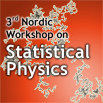Speaker
Prof.
Jonas Tegenfeldt
(Department of Physics, Lund University and Department of Physics, University of Gothenburg)
Description
In my presentation I will touch on three topics with
fundamental interest and with relevance to biomedical
applications. All involve DNA stretched by confinement in
nanofluidic channels: (1) orientational correlations, (2)
force-extension measurements, and (3) barcode labeling.
The behavior of DNA confined into a nanochannel with a
effective cross sectional diameter less than the radius of
gyration of the polymer have been described by two theories.
For effective diameters less than the persistence length
Odijk has devised a model where the DNA undulates between
the walls. For effective diameters greater than the
persistence length deGenne's blob theory predicts a powerlaw
dependence of the extension as a function of the effective
diameter with an exponent of -2/3. However, although
deGennes blob theory correctly predict some of the
characteristics of experimental results, the predicted
exponent is not reproduced and with careful measurements we
show that the behavior does not even follow a power law.
Using Monte Carlo simulations together with a mean-field
theory we develop a model based on local orientational
correlations that better predict the global properties of
the DNA that we observe in our measurements.
Using force-extension measurements we probe the effect of
confinement on the elastic properties of DNA. The results
have strong biological relevance due to the high degree of
crowding in natural environments. The measurements take
place in a device with two microscale channels connected by
a nano-slit. The DNA is attached to a magnetic bead and
introduced into one of the microchannels. The DNA is
subsequently allowed to pass through the nanoslit and
finally bound to the surface of the opposite microchannel.
With a magnetic tweezers a force is exerted on the DNA while
the total extension is observed. For deep slits and for high
forces the force extension curve follows the bulk
Marco-Siggia model. However for strong confinement and for
low forces the fluctuations in one dimension are suppressed,
lowering the required force for a given extension. A
modified Marco_Siggia model is developed and is found to be
consistent with our observations.
The direct visualization of DNA stretched in nanochannels
opens up for interesting applications in genomics, oncology
and infectious disease. We have developed a simple labeling
technique that results in a pattern along the DNA that is
based on the local melting and thus a function of the
underlying sequence. I will discuss the prospects of this
technique along with recent results.

